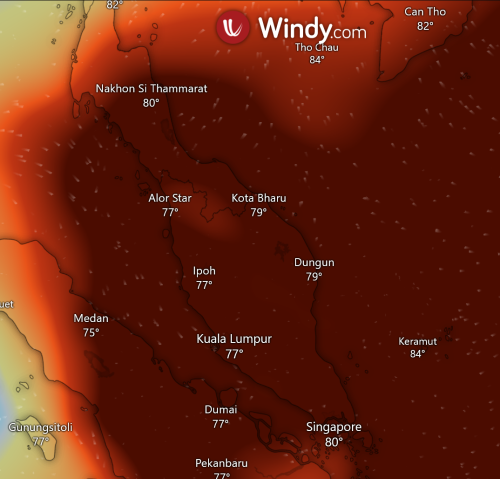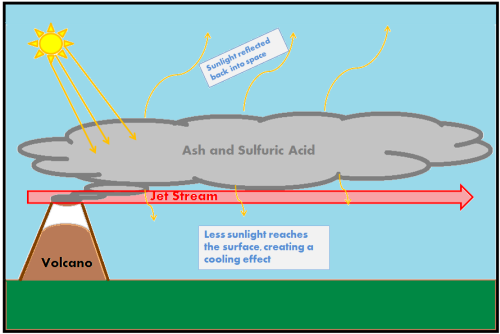-
IP addresses are NOT logged in this forum so there's no point asking. Please note that this forum is full of homophobes, racists, lunatics, schizophrenics & absolute nut jobs with a smattering of geniuses, Chinese chauvinists, Moderate Muslims and last but not least a couple of "know-it-alls" constantly sprouting their dubious wisdom. If you believe that content generated by unsavory characters might cause you offense PLEASE LEAVE NOW! Sammyboy Admin and Staff are not responsible for your hurt feelings should you choose to read any of the content here. The OTHER forum is HERE so please stop asking.
You are using an out of date browser. It may not display this or other websites correctly.
You should upgrade or use an alternative browser.
You should upgrade or use an alternative browser.
[PSA] Sulphur dioxide level is very high in Singapore and Malaysia after Indonesian volcanic eruption..
- Thread starter gsbslut
- Start date
www.channelnewsasia.com
Asia
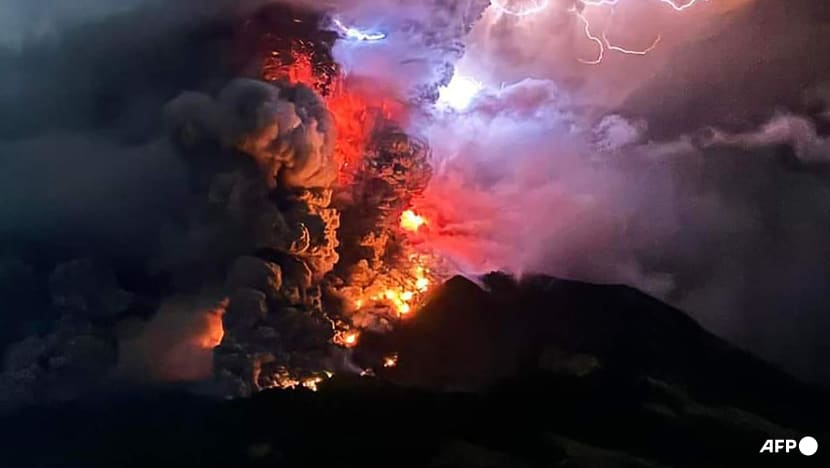 This handout photograph taken and released by the Center for Volcanology and Geological Hazard Mitigation on Apr 17, 2024, shows Mount Ruang spewing hot lava and smoke as seen from Sitaro, North Sulawesi. (Photo: Handout/Center for Volcanology…see more
This handout photograph taken and released by the Center for Volcanology and Geological Hazard Mitigation on Apr 17, 2024, shows Mount Ruang spewing hot lava and smoke as seen from Sitaro, North Sulawesi. (Photo: Handout/Center for Volcanology…see more
18 Apr 2024 12:35PM (Updated: 18 Apr 2024 07:30PM)
MANADO: Indonesian rescuers raced to evacuate thousands of people on Thursday (Apr 18) after a volcano erupted five times, forcing authorities to close a nearby airport and issue a warning about falling debris that could cause a tsunami.
Mount Ruang's crater flamed with lava against a backdrop of lightning bolts overnight after erupting four times on Wednesday, pushing an ash column more than a mile into the sky and forcing authorities to raise its alert level to the highest of a four-tiered system.
Taka, a local fisherman who only gave one name, was at sea helping people to safety by boat when the crater unleashed a fiery orange column.
"There was a mix of fire and rocks. Lava flowed in various directions," he told AFP.
The volcano, which sits on a remote island in Indonesia's outermost region with a peak 725m above sea level, was still billowing a column of smoke up to 800m high on Thursday morning, officials said.
Houses on the neighbouring remote island of Tagulandang were riddled with holes from falling volcanic rocks, and residents were preparing to leave at least temporarily.
"The current condition, particularly the road condition, is covered by volcanic material," local rescuer Ikram Al Ulah told AFP by phone from the Tagulandang seaport.
"Currently, many people are still wandering around. Maybe to evacuate precious goods from their house."
There were no reports of deaths or injuries but authorities said they were rushing to evacuate more than 11,000 residents from the area around Tagulandang, home to around 20,000 people.
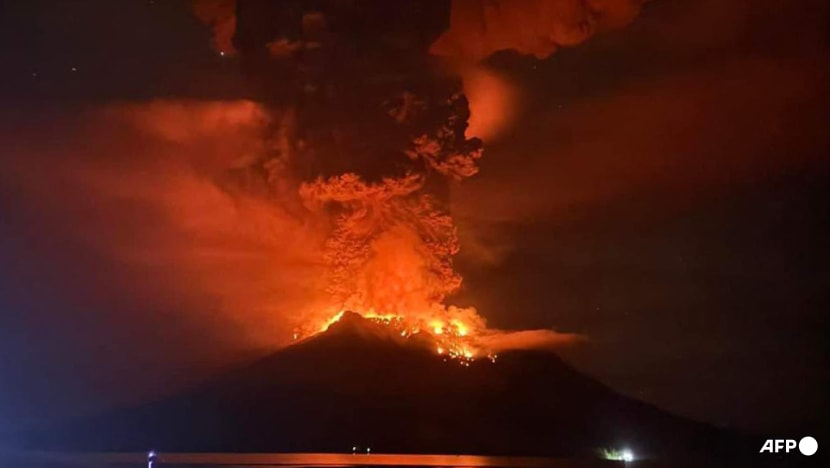 This handout photograph taken and released by the Center for Volcanology and Geological Hazard Mitigation on Apr 17, 2024, shows Mount Ruang releasing hot lava and smoke in Sangihe Islands as seen from Sitaro, North Sulawesi. (Photo:…see more
This handout photograph taken and released by the Center for Volcanology and Geological Hazard Mitigation on Apr 17, 2024, shows Mount Ruang releasing hot lava and smoke in Sangihe Islands as seen from Sitaro, North Sulawesi. (Photo:…see more
"People evacuated on their own but without direction due to the volcano's eruption and ... small rocks that fell," local search and rescue agency official Jandry Paendong said in a statement on Thursday.
"The people scattered to find evacuation routes."
He said 20 staff were helping evacuate residents along the coastline near the volcano on rubber boats.
Authorities also evacuated a prison on Tagulandang island, ferrying 17 inmates along with 11 officials and 19 residents by boat to Likupang seaport in northern Sulawesi island, according to Ikram.
The evacuation was requested by the prison chief because the facility sits directly across from the volcano, said the rescuer.
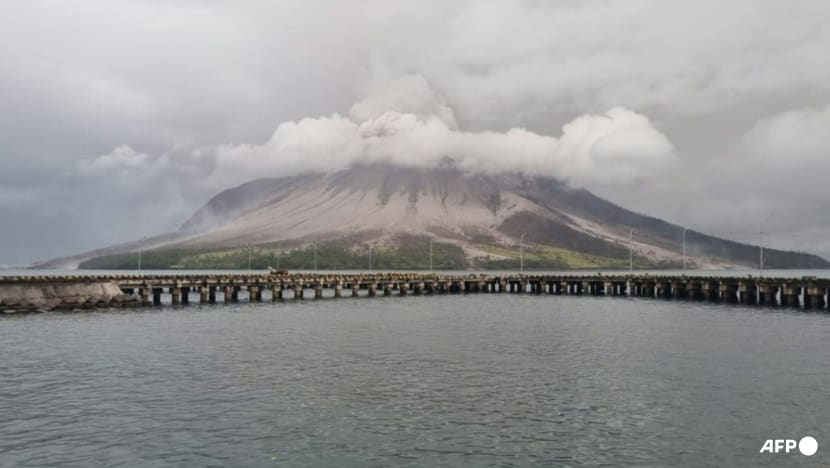 A handout photo taken and released by Center for Volcanology and Geological Hazard Mitigation (PVMBG) on Apr 18, 2024 shows Mount Ruang spewing smoke in Sitaro, North Sulawesi. (Photo: Handout/Center for Volcanology and Geological Hazard…see more
A handout photo taken and released by Center for Volcanology and Geological Hazard Mitigation (PVMBG) on Apr 18, 2024 shows Mount Ruang spewing smoke in Sitaro, North Sulawesi. (Photo: Handout/Center for Volcanology and Geological Hazard…see more
Tourists and residents were warned to remain outside a 6km exclusion zone.
More than 800 people were initially taken to safety from Ruang to nearby Tagulandang island after the first eruption on Tuesday evening, before four more eruptions on Wednesday prompted evacuations from that island.
"The communities in Tagulandang island, particularly those residing near the beach, (need) to be on alert for the potential ejection of incandescent rocks, hot clouds discharges and tsunami caused by the collapse of the volcano's body into the sea," Hendra Gunawan, head of Indonesia's volcanology agency, said in a statement Wednesday.
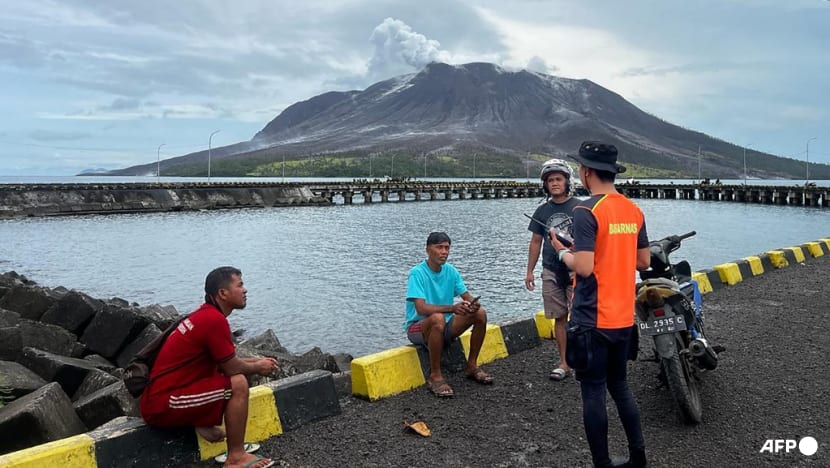 This handout from Indonesia's National Search and Rescue Agency (BASARNAS) received on Apr 18, 2024, shows a member of Basarnas talking to residents in Sitaro, North Sulawesi as the Mount Ruang volcano is seen in the background spewing…see more
This handout from Indonesia's National Search and Rescue Agency (BASARNAS) received on Apr 18, 2024, shows a member of Basarnas talking to residents in Sitaro, North Sulawesi as the Mount Ruang volcano is seen in the background spewing…see more
The authorities' fears were compounded by previous experience.
In 2018, the crater of Mount Anak Krakatoa between Java and Sumatra islands partly collapsed when a major eruption sent huge chunks of the volcano sliding into the ocean, triggering a tsunami that killed more than 400 people and injured thousands.
Indonesia, a vast archipelago nation, experiences frequent seismic and volcanic activity due to its position on the Pacific "Ring of Fire", an arc where tectonic plates collide that stretches from Japan through Southeast Asia and across the Pacific basin.
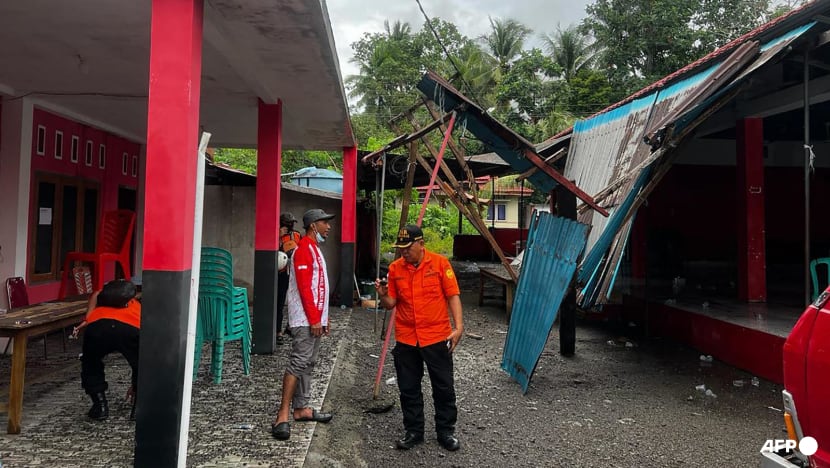 This handout from Indonesia's National Search and Rescue Agency (BASARNAS) received on Apr 18, 2024 shows damage to a building in Sitaro, North Sulawesi that resulted after the Mount Ruang volcano erupted. (Photo: Handout/National Search…see more
This handout from Indonesia's National Search and Rescue Agency (BASARNAS) received on Apr 18, 2024 shows damage to a building in Sitaro, North Sulawesi that resulted after the Mount Ruang volcano erupted. (Photo: Handout/National Search…see more
The impact of Mount Ruang's eruption led to the closure of Sam Ratulangi International Airport in Manado city, located more than 100km from the volcano, for 24 hours until Thursday evening before being extended to midnight.
The airport runways were shut "due to the spread of volcanic ash which could endanger flight safety", Ambar Suryoko, head of the Manado region airport authority office, said in a statement.
The airport hosts airlines that fly to Singapore and cities in South Korea and China.
Budget airline AirAsia also cancelled flights to and from nine airports in eastern Malaysia and Brunei until Friday morning "due to (the) Mount Ruang eruption", it wrote on social media platform X.
The volcano's last major eruption was in 2002, causing damage to nearby settlements and also requiring the evacuation of residents.
Locals this time around expressed their shock on social media.
One posted video showed a swarm of electricity coming from multiple lightning bolts as lava shot into the air.
"Oh God! Oh God! Oh God!" a man is heard saying.
Asia
Thousands evacuated as Indonesia's Ruang volcano erupts, causes tsunami threat

18 Apr 2024 12:35PM (Updated: 18 Apr 2024 07:30PM)
MANADO: Indonesian rescuers raced to evacuate thousands of people on Thursday (Apr 18) after a volcano erupted five times, forcing authorities to close a nearby airport and issue a warning about falling debris that could cause a tsunami.
Mount Ruang's crater flamed with lava against a backdrop of lightning bolts overnight after erupting four times on Wednesday, pushing an ash column more than a mile into the sky and forcing authorities to raise its alert level to the highest of a four-tiered system.
Taka, a local fisherman who only gave one name, was at sea helping people to safety by boat when the crater unleashed a fiery orange column.
"There was a mix of fire and rocks. Lava flowed in various directions," he told AFP.
The volcano, which sits on a remote island in Indonesia's outermost region with a peak 725m above sea level, was still billowing a column of smoke up to 800m high on Thursday morning, officials said.
Houses on the neighbouring remote island of Tagulandang were riddled with holes from falling volcanic rocks, and residents were preparing to leave at least temporarily.
"The current condition, particularly the road condition, is covered by volcanic material," local rescuer Ikram Al Ulah told AFP by phone from the Tagulandang seaport.
"Currently, many people are still wandering around. Maybe to evacuate precious goods from their house."
There were no reports of deaths or injuries but authorities said they were rushing to evacuate more than 11,000 residents from the area around Tagulandang, home to around 20,000 people.

"PEOPLE SCATTERED"
Some residents were already trying to flee in a panic, according to officials."People evacuated on their own but without direction due to the volcano's eruption and ... small rocks that fell," local search and rescue agency official Jandry Paendong said in a statement on Thursday.
"The people scattered to find evacuation routes."
He said 20 staff were helping evacuate residents along the coastline near the volcano on rubber boats.
Authorities also evacuated a prison on Tagulandang island, ferrying 17 inmates along with 11 officials and 19 residents by boat to Likupang seaport in northern Sulawesi island, according to Ikram.
The evacuation was requested by the prison chief because the facility sits directly across from the volcano, said the rescuer.

Tourists and residents were warned to remain outside a 6km exclusion zone.
More than 800 people were initially taken to safety from Ruang to nearby Tagulandang island after the first eruption on Tuesday evening, before four more eruptions on Wednesday prompted evacuations from that island.
TSUNAMI WARNING
Authorities also warned of a possible tsunami as a result of the eruptions."The communities in Tagulandang island, particularly those residing near the beach, (need) to be on alert for the potential ejection of incandescent rocks, hot clouds discharges and tsunami caused by the collapse of the volcano's body into the sea," Hendra Gunawan, head of Indonesia's volcanology agency, said in a statement Wednesday.

The authorities' fears were compounded by previous experience.
In 2018, the crater of Mount Anak Krakatoa between Java and Sumatra islands partly collapsed when a major eruption sent huge chunks of the volcano sliding into the ocean, triggering a tsunami that killed more than 400 people and injured thousands.
Indonesia, a vast archipelago nation, experiences frequent seismic and volcanic activity due to its position on the Pacific "Ring of Fire", an arc where tectonic plates collide that stretches from Japan through Southeast Asia and across the Pacific basin.

The impact of Mount Ruang's eruption led to the closure of Sam Ratulangi International Airport in Manado city, located more than 100km from the volcano, for 24 hours until Thursday evening before being extended to midnight.
The airport runways were shut "due to the spread of volcanic ash which could endanger flight safety", Ambar Suryoko, head of the Manado region airport authority office, said in a statement.
The airport hosts airlines that fly to Singapore and cities in South Korea and China.
Budget airline AirAsia also cancelled flights to and from nine airports in eastern Malaysia and Brunei until Friday morning "due to (the) Mount Ruang eruption", it wrote on social media platform X.
The volcano's last major eruption was in 2002, causing damage to nearby settlements and also requiring the evacuation of residents.
Locals this time around expressed their shock on social media.
One posted video showed a swarm of electricity coming from multiple lightning bolts as lava shot into the air.
"Oh God! Oh God! Oh God!" a man is heard saying.
april give acid rain, come september give haze...what good neighbors we have.
the Sulphur dioxide levels looks bad this morning...april give acid rain, come september give haze...what good neighbors we have.
Health effects of sulfur dioxide
Breathing in sulfur dioxide can impact your health. When levels are high, you can experience symptoms shortly after you breathe it in.Symptoms include wheezing, coughing and shortness of breath. People with lung conditions like asthma are most affected by high levels of sulfur dioxide.
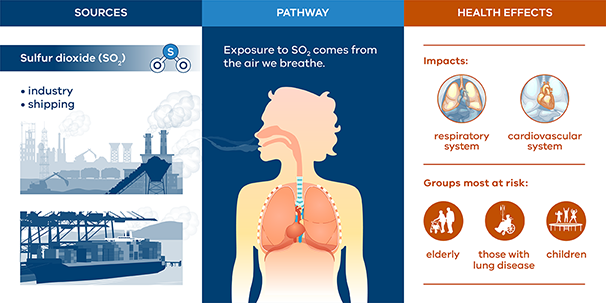
www.webmd.com
 When acidic components get into rain or other forms of precipitation, acid rain can make trees die. It won't hurt you to walk or swim in acid rain, but the particles that cause it may hurt your lungs if you breathe them in. (Photo Credit: The Image Bank/Getty Images)
When acidic components get into rain or other forms of precipitation, acid rain can make trees die. It won't hurt you to walk or swim in acid rain, but the particles that cause it may hurt your lungs if you breathe them in. (Photo Credit: The Image Bank/Getty Images)
Acid rain is a broad term for any precipitation that has more acid in it than normal. For example, acid rain may have sulfuric acid or nitric acid. Precipitation includes not only rain but also fog, hail, sleet, and snow. Acid rain can hurt the environment and your health. Some of the gasses that cause acid rain can also speed up climate change.
Acid rain comes in two forms:
Wet. The compounds turn into acids in the atmosphere and fall down as rain, sleet, snow, fog, or hail.
Dry. This is when compounds produce acids and float down to the ground as dust and gas. Future rains can spread them even more. You can also breathe it in.
You might not hear about acid rain as much as you used to. In the U.S., the 1990 Clean Air Act Amendments helped lower the levels of pollutants that cause rain to become more acidic. But acid rain still falls across the globe.
Acid rain pH
The pH scale ranges from 0 to 14. It tells you how acidic something is. Seven, in the middle, is neutral like pure water. A pH less than 7 means a substance is acidic. A pH over 7 means something is basic (alkaline) and not acidic. To get a better sense of what this means, it may help to know the pH levels of everyday items or other substances:
Primary sources of sulfur dioxide and nitrogen oxides in the atmosphere are:
These acids usually mix with water and fall to the ground as precipitation. Sometimes, when there isn’t enough moisture, the particles fall to the ground and land on surfaces like bodies of water, buildings, trees, and plants. When precipitation eventually comes, it can wash the particles into the soil and bodies of water.
If you’re exposed to high concentrations of nitric and sulfuric acid -- especially over time -- it may cause these problems:
The inability of the young to survive isn’t the only threat to species. Acid rain can also disrupt food chains. For example, while frogs can survive in water with a pH as low as 4, the mayflies they eat may not survive below a pH of 5.5. This can have a cascading effect, wherein even if a species can survive the acidity, they may still starve. This includes not just aquatic animals but also animals such as bears and wolves.
Other effects of acid rain on the environment include:
Bodies of water. Acid rain can increase the dangers of lakes, rivers, and streams more than you might expect. When acid rain falls to the ground and flows into the soil, it absorbs aluminum from the surrounding soil. This then flows into the lakes, rivers, and streams and can make the water toxic to the creatures that live there.
Plants and forests. Acid rain can destroy nutrients such as calcium and magnesium that keep trees healthy. It releases aluminum, which makes it tougher for trees to get water from the ground. Trees located at higher elevations are more prone to acidic clouds and fog as well.
Buildings. Chemicals from acid rain can break down stone and metal on structures. This can wear down surfaces and fade finishes.
Soil. Generally, limestone (a base) in the ground helps neutralize the acid. But acid rain can affect soil that doesn’t contain much limestone. Also, the chemicals can trickle into the groundwater. That can acidify major waterways, too.
Visibility. Particles in the air, like other forms of pollution, can cause smog and haze. This not only gets in the way of your view but can also be dangerous to travel in.
Serious acid rain is a problem in parts of China and elsewhere in Asia that are rapidly industrializing.
What Is Acid Rain?

Acid rain is a broad term for any precipitation that has more acid in it than normal. For example, acid rain may have sulfuric acid or nitric acid. Precipitation includes not only rain but also fog, hail, sleet, and snow. Acid rain can hurt the environment and your health. Some of the gasses that cause acid rain can also speed up climate change.
Acid rain comes in two forms:
Wet. The compounds turn into acids in the atmosphere and fall down as rain, sleet, snow, fog, or hail.
Dry. This is when compounds produce acids and float down to the ground as dust and gas. Future rains can spread them even more. You can also breathe it in.
You might not hear about acid rain as much as you used to. In the U.S., the 1990 Clean Air Act Amendments helped lower the levels of pollutants that cause rain to become more acidic. But acid rain still falls across the globe.
Acid rain pH
The pH scale ranges from 0 to 14. It tells you how acidic something is. Seven, in the middle, is neutral like pure water. A pH less than 7 means a substance is acidic. A pH over 7 means something is basic (alkaline) and not acidic. To get a better sense of what this means, it may help to know the pH levels of everyday items or other substances:
- 0 (very acidic): Battery acid
- 1: Stomach acid
- 2: Lemon juice or vinegar
- 3: Orange juice or soda
- 4: Tomato juice
- 5: Black coffee
- 6: Urine or milk
- 7: Pure water
- 8: Seawater
- 9: Baking soda
- 10: The Great Salt Lake
- 11: Ammonia
- 12: Soapy water
- 13: Bleach
- 14 (very basic or alkaline): Liquid drain cleaner
Acid Rain Causes
Acid rain forms when water and oxygen in normal precipitation mix with chemicals such as sulfur dioxide and nitrogen oxides. The chemical reaction turns normal rain more acidic.Primary sources of sulfur dioxide and nitrogen oxides in the atmosphere are:
- Power plants. Two-thirds of sulfur dioxide and a quarter of nitrogen oxides in the atmosphere come from electric power generators.
- Vehicles and heavy equipment.
- Other industries. Examples include manufacturing and oil refineries.
These acids usually mix with water and fall to the ground as precipitation. Sometimes, when there isn’t enough moisture, the particles fall to the ground and land on surfaces like bodies of water, buildings, trees, and plants. When precipitation eventually comes, it can wash the particles into the soil and bodies of water.
Acid Rain Effects on Humans
Acid rain can harm your health. But the danger doesn’t come from swimming in a lake containing acid rain or getting wet from acidic raindrops. The harm comes from breathing in particles from acid rain.If you’re exposed to high concentrations of nitric and sulfuric acid -- especially over time -- it may cause these problems:
- Irritation to the eyes, skin, and mucous membranescan come from contact with one or both acids.
- Fluid in the lungs,or pulmonary edema, can happen if you breathe in nitric acid.
- Dental erosion, if acids wear down the enamel on your teeth.
- Respiratory illnesses, including chronic bronchitis, pneumonia, and asthma
- Cardiovascular problems, such as existing heart disease
- Lower birth weight, which might affect a child’s growth and development
- Lung cancer, if chemicals in the air you breathe cause cells in your lungs to turn cancerous
Acid Rain Effects on Animals and the Environment
Acid rain not only harms human health but is also damaging to animals. Animals that live in aquatic environments, such as lakes, rivers, and streams, are most affected by acid rain. While not all animals are sensitive to acidity, creatures such as clams and snails need a pH of at least 6 to survive. The young of many species often don’t handle acidity as well as the adults. While an adult fish may be able to handle water with a lower pH, their eggs may not hatch.The inability of the young to survive isn’t the only threat to species. Acid rain can also disrupt food chains. For example, while frogs can survive in water with a pH as low as 4, the mayflies they eat may not survive below a pH of 5.5. This can have a cascading effect, wherein even if a species can survive the acidity, they may still starve. This includes not just aquatic animals but also animals such as bears and wolves.
Other effects of acid rain on the environment include:
Bodies of water. Acid rain can increase the dangers of lakes, rivers, and streams more than you might expect. When acid rain falls to the ground and flows into the soil, it absorbs aluminum from the surrounding soil. This then flows into the lakes, rivers, and streams and can make the water toxic to the creatures that live there.
Plants and forests. Acid rain can destroy nutrients such as calcium and magnesium that keep trees healthy. It releases aluminum, which makes it tougher for trees to get water from the ground. Trees located at higher elevations are more prone to acidic clouds and fog as well.
Buildings. Chemicals from acid rain can break down stone and metal on structures. This can wear down surfaces and fade finishes.
Soil. Generally, limestone (a base) in the ground helps neutralize the acid. But acid rain can affect soil that doesn’t contain much limestone. Also, the chemicals can trickle into the groundwater. That can acidify major waterways, too.
Visibility. Particles in the air, like other forms of pollution, can cause smog and haze. This not only gets in the way of your view but can also be dangerous to travel in.
Where Does Acid Rain Fall?
Wind can carry acid rain dust around the globe far from the source of the pollution. The U.S. tracks the chemicals in acid rain. The Northeastern region is the most acidic because it has many power and industrial plants, people, and cities. Many plants in the Midwest release harmful chemicals that also blow to the Northeast, increasing the acidity. Also, the soil in the Northeast is less likely to be able to neutralize the acid rain.Serious acid rain is a problem in parts of China and elsewhere in Asia that are rapidly industrializing.


Air pollution like sulfur dioxide and nitrogen oxides can cause respiratory diseases, or can make these diseases worse. Respiratory diseases like asthma or chronic bronchitis make it hard for people to breathe. The pollution that causes acid rain can also create tiny particles. When these particles get into people’s lungs, they can cause health problems, or can make existing health problems worse. Also, nitrogen oxides cause ground-level ozone. This ground-level ozone causes respiratory problems, like pneumonia and bronchitis, and can even cause permanent lung damage. The health effects that people have to worry about are not caused by the acid rain, but are caused when people breathe in these tiny particles or ozone. Swimming in an acidic lake or walking in an acidic puddle is no more harmful to people than swimming or walking in clean water. |
sg surrounded by volcanoes. no wonder air quality so poor.
Living condition is too bad for the property owners. They should just sell their condos and landed property now
The SO2 level is still very very high at 1pm ... source from windy.comsg surrounded by volcanoes. no wonder air quality so poor.
Similar threads
- Replies
- 1
- Views
- 526
- Replies
- 5
- Views
- 709
- Replies
- 19
- Views
- 1K
- Replies
- 0
- Views
- 454

